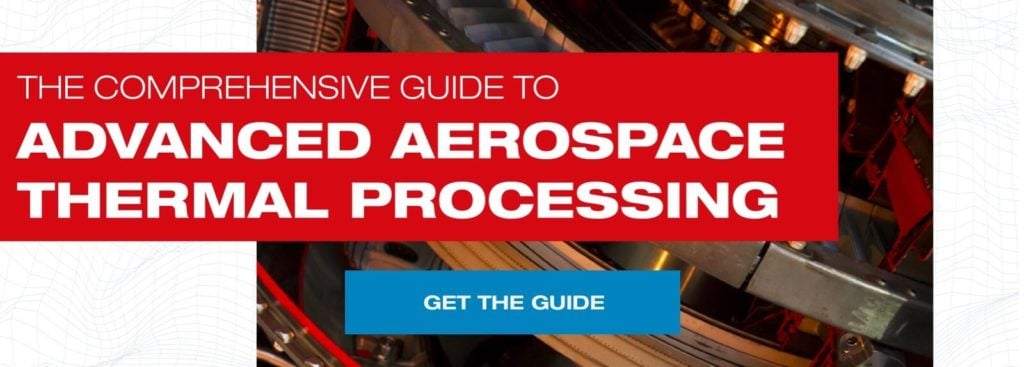Additive manufacturing has given engineers in aerospace, power generation and many other sectors the opportunity to craft high-performance parts once thought impossible.
The rise of additive-manufactured high-performance parts has led to incredible collaboration with heat treaters in efforts to enhance the mechanical properties of these next-generation components and fuel the launch into commercial space.
Inconel 718 is one of the common nickel-based superalloys often used to create these mission-critical parts. This discussion summarizes the main production steps: Selective laser melting, hot isostatic pressing, and heat treatment.

Inconel 718 Composition
Inconel 718 is a high-performance composition owned by the Special Metals Corporation generically referred to as Alloy 718. This nickel-based superalloy, and others like it, are favored materials in space, aerospace and power generation due to their superior performance in high-heat, high-stress environments like jet engines, rocket engines and gas turbines.
Inconel 718 is composed of 50 – 55% nickel, 17 – 21% chromium, 4.75 – 5.5% niobium and 2.8 – 3.3% molybdenum. In addition, smaller amounts of cobalt, manganese, copper, titanium, aluminum, silicon, carbon, sulfur, phosphorus and boron are present. Production and processing of Inconel 718 is referenced in many standards, some of which are:
- AMS5596 for sheets, strips, foils and plates.
- AMS5662 for bars, forgings and rings.
- AMS2774 for heat treatment.
- ASTM F3055, which covers additive manufacturing of nickel alloys via powder bed fusion.
- Inconel 718 is identified as N07718 under the Unified Numbering System adopted by ASTM and SAE.
Other common superalloy trade names you’ll encounter include various Monel, Incoloy, Hastelloy, Haynes, René and Mar.
Inconel 718 hardness and other mechanical properties
This superalloy is revered for its high strength from cryogenic temperatures up to 1,300 degrees Fahrenheit. It’s especially effective when used in hot-section components of jet and rocket engines because it retains its mechanical integrity at high temperature over long periods of time. Inconel 718’s face-centered cubic base structure and precipitation strengthening capability allow it to resist the gradual deformation or sudden rupture of a part routinely under high stress (the phenomena are called creep rupture and stress rupture, respectively).
Depending on its manufacture and heat treatment, Inconel 718 parts usually achieve a hardness of around 36 HRC. That’s quite soft compared to other high-hardness steels used in machining, die casting or some automotive applications. But in the aerospace and power generation applications for which Inconel 718 is best suited, hardness isn’t the point. The mechanical properties under high stress and high temperatures are most important.
Powder bed fusion in additive manufacturing
Powder bed fusion refers to a group of additive manufacturing techniques that includes selective laser melting, direct metal laser sintering and electron beam melting. In these processes, a part is printed layer by layer when either a laser or electron beam is precisely fired at metallic powder in the presence of an inert gas.
Generically, it’s referred to as additive manufacturing or metal 3D printing.
The process has gained traction because it results in the creation of very strong parts with precise, complex shapes that would be very difficult (and sometimes impossible) to make by any other means.
Inconel 718 is a popular alloy for powder bed fusion because it’s one of the more easily accessed nickel-based superalloy powders. Additive manufacturing—and particularly the laser-sintered powder bed fusion process—puts high stress on parts. Before any further processing can begin, printed parts should be stress relieved.
Hot isostatic pressing (HIP)
In mission-critical aerospace and power generation applications, part performance must be maximized. Choosing the ideal material goes a long way, but HIP is an integral step in the process. This high-temperature, high-pressure process strengthens metal parts by eliminating internal voids that form during manufacturing.
HIP was originally introduced to combat the phenomenon of casting porosity. It’s evolved to become a preferred thermal process of additive manufactured parts to maximize mechanical performance and longevity. The diffusion bonding of dissimilar metals is also executed via HIP.
For Inconel 718 and similar superalloys, HIP is carried out at around 2,200 degrees Fahrenheit at up to 1,700 bar (25 ksi). While HIP can result in shape changes in parts containing large voids, additive manufactured parts tend only to have very small pores. It results in a net shape that remains essentially unchanged after HIP is complete.
As a result of HIP, parts can display:
- Improved performance in high-heat, high-fatigue service.
- Increased impact resistance.
- Increased wear and abrasion resistance.
- Better ductility.
- Increased tensile strength.
Heat treating Inconel 718
The recommended heat treatment of Inconel 718 is solution treating followed by precipitation hardening.
In solution treating, parts in a vacuum furnace are heated up to and then held at a temperature sufficient to promote dissolution of its soluble phases. This homogenizes the structure of the part. Solution treating is followed by quenching with argon. Because solution treatment results in softer parts, they must be hardened back up before additional processing or end use.
Precipitation hardening (also known as aging) is carried out in vacuum furnaces over many hours at lower temperatures compared to solution treating. This gradual process allows for some diffusional movement within a part that increases its strength. The amount of time a part is aged will impact its hardness, but heat treaters must be careful not to age parts too long. Overaging will cause parts to soften.
For more information about thermal processing of additive manufactured parts, consult ASTM F3301, which covers thermal post-processing of metal parts made via powder bed fusion.
Process expertise from Paulo
Paulo takes processing and heat treating Inconel 718 and other superalloys to the next level. Now offering HIP services in addition to other leading heat treatments, we maximize the performance of key rocket engine and power generation components.
All our processes are carried out in cutting-edge heat treating equipment backed by the industry’s most experienced operators and best process control software. This combination guarantees your high-performance parts are treated exactly as specified—no errors, no waste.
If you want to learn more about innovative heat treating techniques for the space industry, check out our Essential Guide to Thermal Processing for Space and Additive Manufacturing. If you’re looking for guidance on processing and heat treating Inconel 718 or other high-performance superalloys, we’re ready to help.



